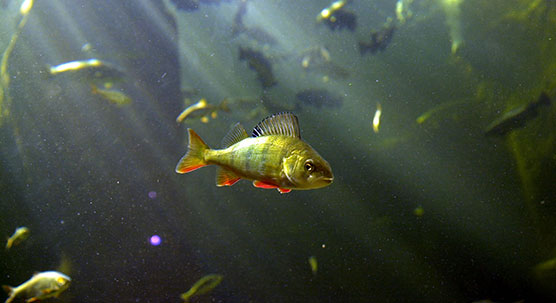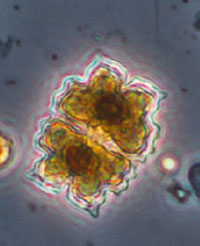Press release 2016-09-30 at 12:07

Photo: Riku Lumiaro
Press release from University of Eastern Finland, University of Jyväskylä, University of Helsinki and Finnish Environment Institute
Eutrophication and brownification change phytoplankton community structure and decrease production of essential omega-3 fatty acids in lakes. Perch growing in oligotrophic clear-water lakes contain 1.5-1.9 times more essential omega-3 fatty acids than those grown in eutrophic and brown-water lakes.
Fish are known to be high-quality food for humans because of their high content of polyunsaturated fatty acids, essential for human health. The most important and best known polyunsaturated omega-3 fatty acids are EPA and DHA. However, fish are dependent on algae producing the essential omega-3 fatty acids, which are then transferred in the food chain via zooplankton to fish. All algal groups are not capable to synthetize EPA and DHA. Cryptophytes, diatoms, chrysophytes and dinophytes are the most important algal groups producing these essential fatty acids. These algal groups predominate in phytoplankton communities of oligotrophic clear-water lakes.
Eutrophication is mainly due to increasing phosphorus concentration in the lakes. Brownification is due to increased leaching of terrestrial humic matter to aquatic ecosystems. Both these phenomena change lake phytoplankton community composition and the proportion of EPA and DHA producing algae tends to decline. Especially blue-green and green algae, poor in omega-3 fatty acids, benefit from eutrophication.

Euastrum bidentatum, phytoplankton. Photo: Reija Jokipii
A group of scientists from three universities in Finland (University of Eastern Finland, Jyväskylä and Helsinki) and Finnish Environment Institute (SYKE) found that the EPA and DHA content of phytoplankton decreased along with eutrophication and brownification of the lakes. Accordingly, the EPA and DHA content decreased in the muscle of large piscivorous perch. This is the first time when the fatty acid content of phytoplankton is shown to impact the food chain up to predatory fish.
The study was mainly done in a research consortium of AKVA program funded by the Academy of Finland. For the research material 40 different algal taxa were cultured in laboratory and the information of their fatty acid content was combined with phytoplankton community data from more than 700 lakes in Finland, collected by Finnish Environment Institute. Perch were collected from 14 lakes with different phosphorus concentration and water colour.
Eutrophication is still a great problem in many lakes in Finland. During the last decades, brownification of lakes has been detected in the whole northern hemisphere. In eutrophic and brown-water lakes the EPA and DHA content of large perch was 1.5-1.9 times lower than in those from oligotrophic clear-water lakes. Thus, eutrophication and brownification significantly worsen the quality of perch used in human diets.
The results are published in Environment International
Authors:
- S.J. Taipale, University of Eastern Finland, University of Jyväskylä, University of Helsinki
- K. Vuorio, Finnish Environment Institute (SYKE), University of Jyväskylä
- U. Strandberg, University of Eastern Finland
- K.K. Kahilainen, University of Helsinki
- M. Järvinen, Finnish Environment Institute (SYKE)
- M. Hiltunen, University of Eastern Finland
- E. Peltomaa, University of Helsinki
- P. Kankaala, University of Eastern Finland
More information:
Head of unit, docent Marko Järvinen, Finnish Environment Institute (SYKE), tel. +358 29 5251241, firstname.lastname@ymparisto.fi
Consortium leader, docent Paula Kankaala, University of Eastern Finland, tel. +358 29 4453046, firstname.lastname@uef.fi
University lecturer, docent Sami Taipale, University of Jyväskylä, tel. +358 408054121, firstname.lastname@jyu.fi